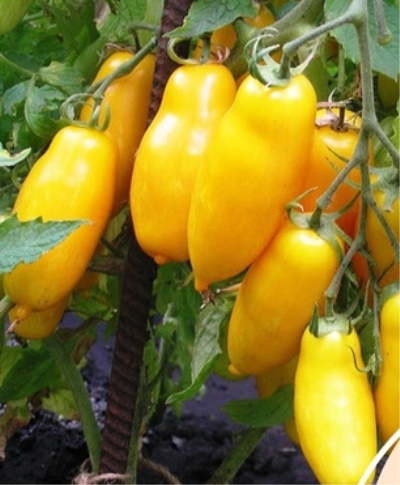
- Category: grade
- Growth type: determinant
- Appointment: universal
- Ripening period: early
- Ripening time, days: 90-95
- Growing conditions: for open ground, for closed ground
- Bush size: medium-sized
- Bush height, cm: in the greenhouse - up to 150, in the open field - 60-80
- Ripe fruit color: yellow
- Fruit shape: oval, with a "nose"
The name Firewood yellow sounds bold and expressive. But you cannot limit yourself to information about the color of this tomato. You should also familiarize yourself with its real consumer characteristics, which every farmer should know.
Description of the variety
Yellow firewood is a good determinant variety. And also note its decent versatility. Bushes in greenhouse conditions can grow up to 1.5 m.If the plants are planted in open ground, they will rise to 0.6-0.8 m.
The main qualities of the fruit
As the name of the culture suggests, it produces yellow berries. The usual mass of tomatoes is 70-90 g. The highest recorded figure is 120 g. The oval shape is characteristic of the fruits. It is complemented by a small "nose".
Taste characteristics
It is worth noting that yellow firewood has a rather dense skin. But it will not have a negative effect on the quality of the fruit. The flesh under the skin is fleshy. It contains only a relatively small amount of seeds.
Ripening and fruiting
Yellow firewood is one of the early tomatoes. The plant can bear fruit 90-95 days after planting in open ground. Harvesting is usually done in July and August. But sometimes the weather makes some corrections, postponing or approaching the beginning of fruiting and its completion.
Yield
In greenhouse conditions, you can achieve a collection of 16 kg per 1 sq. m. In the open field, it is almost impossible to achieve such success. However, this variety is also very attractive as a common garden crop.
The timing of planting seedlings and planting in the ground
Sowing seeds in containers is recommended between March 20 and April 10. In this case, you must carefully monitor the long-term weather forecast. The usual time for disembarking in open soil is between May 15th and June 5th. Additionally, it is necessary to take into account the meteorological situation, the degree of warming of the earth and the condition of the seedlings themselves. An attempt to plant immature plants is unlikely to be successful.

Growing tomato seedlings is an extremely important process, because it largely depends on whether the gardener can harvest at all. All aspects must be taken into account, from seedbed preparation to planting in the ground.
Landing scheme
Usually the 500x400 mm rule is followed. This is a good proven approach, and it doesn't make any sense to deviate from it.

Growing and care
It is simply impossible to do without persistent removal of stepsons and an equally neat garter. Planting material should be taken only from certified suppliers. It should be noted that the exclusive sale is carried out exclusively by Aelita.Due to the limited development of the root system, relatively small seedling containers can be used.
The yellow firewood tomato is widespread in many regions of Russia. However, its cultivation is optimal in Siberia and the Urals. In these areas, the use of seedlings is recommended. In the south of our country, direct sowing into the ground is allowed. However, shelter measures are still needed.
Water the plant 3 times a week. After watering, mulching of the plantings is required. Fertilizer is applied as needed.




A plant needs different micronutrients at each stage of growth. All fertilizers can be divided into two groups: mineral and organic. Folk remedies are often used: iodine, yeast, bird droppings, eggshells.
It is important to observe the rate and period of feeding. This also applies to folk remedies and organic fertilizers.
Disease and pest resistance
Tomato Firewood yellow is not prone to cracking berries. The specific immunity of the plant is quite high. The likelihood of being hit by late blight is present, but mostly after the removal of the main part of the berries. However, preventive treatments are still needed. Apical rot can occur with calcium deficiency.


Review overview
This tomato forms compact bushes that can help out in confined spaces. The yield declared by the suppliers of planting material is fully confirmed in the reviews. The fruits can be successfully used for canning. However, it is possible to grow a variety only with a very careful approach, with strict adherence to the recommendations. The quality of the fruit is, indeed, high gastronomically.

























































































